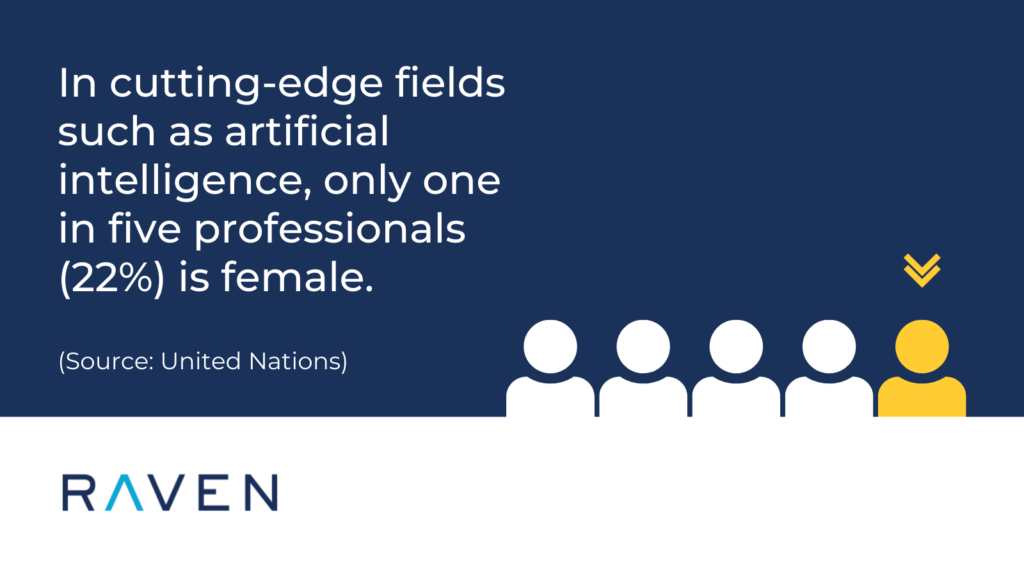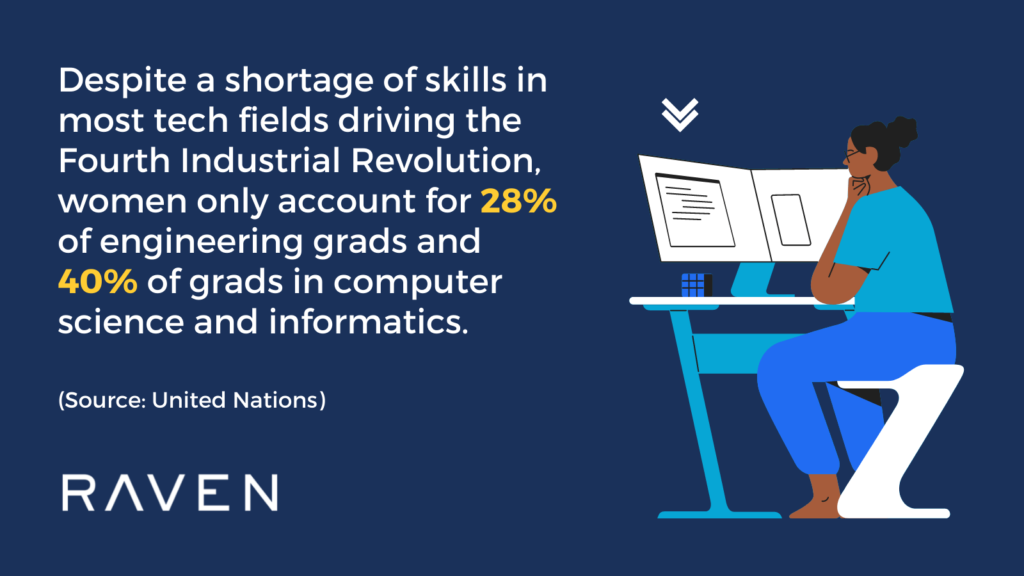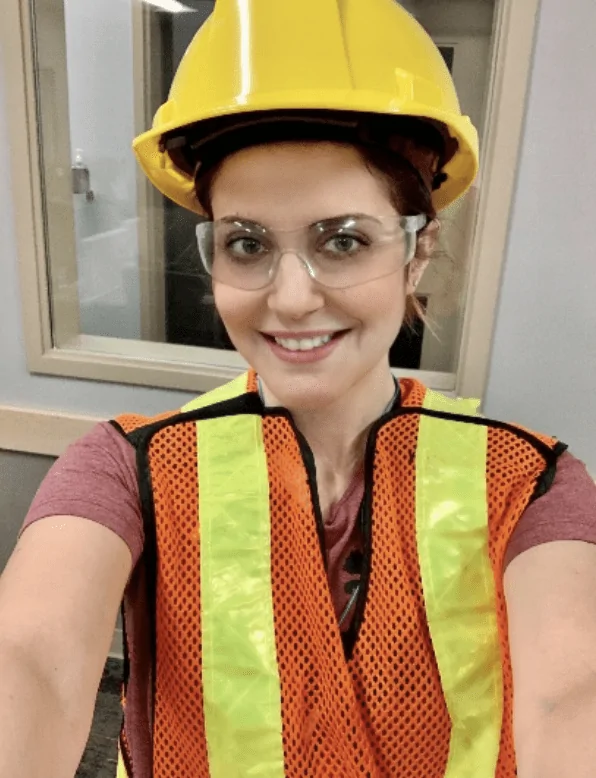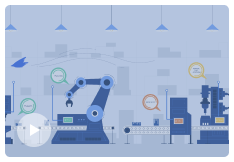On International Women’s Day — and every day — we recognize and reflect on the STEM research and innovation of all the women at Raven and around the globe. The fact is that in cutting-edge fields such as artificial intelligence and automation, only one in five professionals (22%) is female.
Despite a skills shortage in most technology fields driving Industry 4.0, women still account for only 28% of engineering graduates and 40% of graduates in computer science and informatics. Now, with the Fourth Industrial Revolution in full swing, manufacturing and technology as a whole are undergoing massive change — and so should its workforce.
Women in STEM need to be part of the digital economy to prevent Industry 4.0 from allowing long-established gender biases to exist. As the impact of digital technologies continues to grow, the underrepresentation of women’s contributions to R&D means that their perspectives are likely to be overlooked in product designs that impact our day-to-day lives.
Read on to learn about:
- Why women are under-represented in manufacturing
- How we can help #BreakTheBias
- Meet some of the women in STEM at Raven
Why are women under-represented in manufacturing?
Women are leading the charge in education, earning post-secondary degrees at all levels and advancing professionally — in other fields. In the manufacturing world, women hold less than 4.5% of all skilled trades jobs. They also account for just 8.3% of all jobs in transportation and heavy machinery operation, as well as 7.2% of jobs in supervisory and central control operation positions. Since there are plenty of skilled jobs in manufacturing, it would seem like a natural fit for this highly-skilled demographic. The logical conclusion would be that the future of manufacturing is certainly female. However, there remains a significant gender gap. Why aren’t women drawn to manufacturing?The CME strived to find out. Their survey highlighted the major barriers for women considering manufacturing jobs including: sexism, male-centric workplace culture, limited opportunities for advancement, work-life balance issues and a negative perception of manufacturing in general.

What can we do about it?
Deloitte, The Manufacturing Institute and APICS surveyed 600+ women in manufacturing to understand the reasons for the gender gap and figure out ways to close it. Based on their findings, here are some ways we can attract and retain this untapped workforce:
- Start early
- Develop a culture championing DEI
- Focus on work-life balance
- Support professional development
1. Start early
Skilled trades and STEM careers have typically attracted more men than women. To encourage women to consider a career in manufacturing, we have to start earlier. It’s more than just encouraging more females to consider STEM fields. It’s also about changing the way manufacturing is perceived and reflecting the industry as a rewarding, high-skill/high-pay career option. It would help to show women excelling in the field so that women can see themselves in a similar environment. Take action: Include women at the forefront of marketing and recruitment efforts. Open the doors to young women to show off your facilities, debunk common manufacturing myths, communicate your values and highlight female employees. Here’s a great example.
2. Develop a culture championing DEI
A diverse workforce is not just great for employees, it’s great business. Companies that walk the talk and value diversity, equity and inclusion (DEI) at all levels get to see and embrace different perspectives. Diversity of thought encourages inclusion but also innovation, balance, and improved financial performance for your organization. It’s more than putting up a few posters in the lunchroom though. To champion diversity, equity and inclusion, listen. Listen to past, current and future workers and their stories and suggestions. And most importantly, advocate for them.
A lot of companies will want to address their DEI limitations through hiring. And with an emphasis on behavioral and job fit, you can reduce bias in the hiring process. But it also comes down to leadership and championing an inclusive culture from the top-down. The best-oiled and talented companies already have Human Resources at the executive table. But securing buy-in isn’t all on them, even if it appears they have the most immediate capacity to impose change. The rest of your leadership/executive team is also involved in that process. Take action: Companies need to ask hard questions about their workplace, examine biases at every level, and hold the entire organization accountable.

3. Focus on work-life balance
Research shows that women carry most of the load in terms of family commitments and caregiving. However, in most manufacturing facilities, shift work is an unavoidable reality. This can limit women’s availability but also promotion opportunities. Take action: Leadership alongside Human Resources need to find creative ways to understand and accommodate a balanced work-life. Part of your company culture should also encourage work-life balance. This helps your employees and bottom line; happy employees are more productive, and burnout is a primary obstacle to happiness at work. On top of encouraging employees to recharge and use vacation that they’ve earned, teams should be aware of when and how they are communicating inside and outside of “business hours”.
4. Support professional development
Another finding in the Deloitte survey showed that women ranked promotion opportunities and interesting assignments as a top motivator to stay in the manufacturing industry. Additionally, women in STEM are typically given smaller research grants than their male colleagues and, while they represent 33.3% of all researchers, only 12% of members of national science academies are women. It makes sense – a challenging career path with support from management is a big reason to stay in a job. Companies who invest in leadership, mentoring and professional development will see higher rates of retention. Take action: Invest in professional development and mentorship opportunities for women.
The women at Raven rock
Here at Raven, we are surrounded by intelligent, committed and fun women who are working to take innovation and technology in manufacturing to the next level. We are invested in building a company where diversity, inclusion and gender equality are celebrated and valued. We’re proud to share that 45% of our engineering and development team is female. We have 6+ women software developers, 9+ engineers (including our Director of Operations and Director of Engineering) and 10+ women working in other roles across our tech team. As a team supporting women in STEM, we’ve decided to use International Women’s Day as an opportunity to showcase some of the top talent in the industry to inspire other women taking up this profession and to our own, making a huge impact at Raven. Here’s to you ladies!

Name
Lamia Ghoneim
Role
Customer Value Manager
How did you end up in STEM?
In grade school I was like many girls my age; into dolls, pretty clothes and everything “girly”. At the same time, I was also very much into science and math, and had an inquisitive mind that was often overlooked by my teachers and society. My passion for STEM combined with my competitive nature, led me to want to break stereotypes and show that girls can be successful engineers.
What do you love about your work?
Leveraging science and technology to solve complex problems and improve peoples’ lives is the most rewarding aspect of my job. That and the continuous learning and development that comes from being in a rapidly evolving field.
Random fun fact
Oftentimes, the solution to a difficult engineering problem comes to me in a dream.

Name
Ramsha Bukhari
Role
Data Engineer
How did you end up in STEM?
Physics was my favourite subject in high school. The love for physics grew into the love for engineering and I ended up in STEM. Logical reasoning, problem solving and critical thinking became a part of my life ever since.
What do you love about your work?
There are new mysteries to unravel every day. What particularly excites me is seeing problems/errors out of nowhere and then following a structural approach of isolating the issue and coming up with a solution for it. The end is always so satisfying.
Random fun fact
I failed an exam in college because I got hooked on GTA Vice City. Finished the game though!

Name
Aarthi Babu
Role
Full Stack Engineer
How did you end up in STEM?
Passionate teachers who enabled me to perceive everything in terms of science/math and taking part in numerous fun problem solving contests led me to pursue computer sciences in undergrad. Later on, my curiosity and desire to learn new things carried me along my career path.
What do you love about your work?
I love the constant learning and drive towards improving customer experiences. I love the genuine spirit of teamwork and collaboration that turns our ideas into reality.
Random fun fact
I once tried adding sugar to my wine and beer to sweeten it.

Name
Brenda Munyukwi
Role
Head of Operations
How did you end up in STEM?
When I was 7 years old, my mom had a small bottling manufacturing company and I enjoyed watching the process, and was always so intrigued on how the machines were made. Fast forward to high school, my chemistry teacher told me I should not think about taking any sciences at all – I love to shake the status quo. So I became a chemical engineer.
What do you love about your work?
The people I get to interact with.
Random fun fact
I have never eaten an apple.

Name
Laura Dierker
Role
Manager, European Partnerships
How did you end up in STEM?
I wanted to be a violinist as a first career choice. I ended up in STEM when someone told me physics would be too hard for me. My response was “Oh yeah? Just watch me!”.
What do you love about your work?
I love applying technology to people’s problems, and I love understanding enough so that I can really feel confident in the solutions presented. I love engaging and listening and moving forward with our immensely talented company.
Random fun fact
I love to cook and have people over for dinner.





